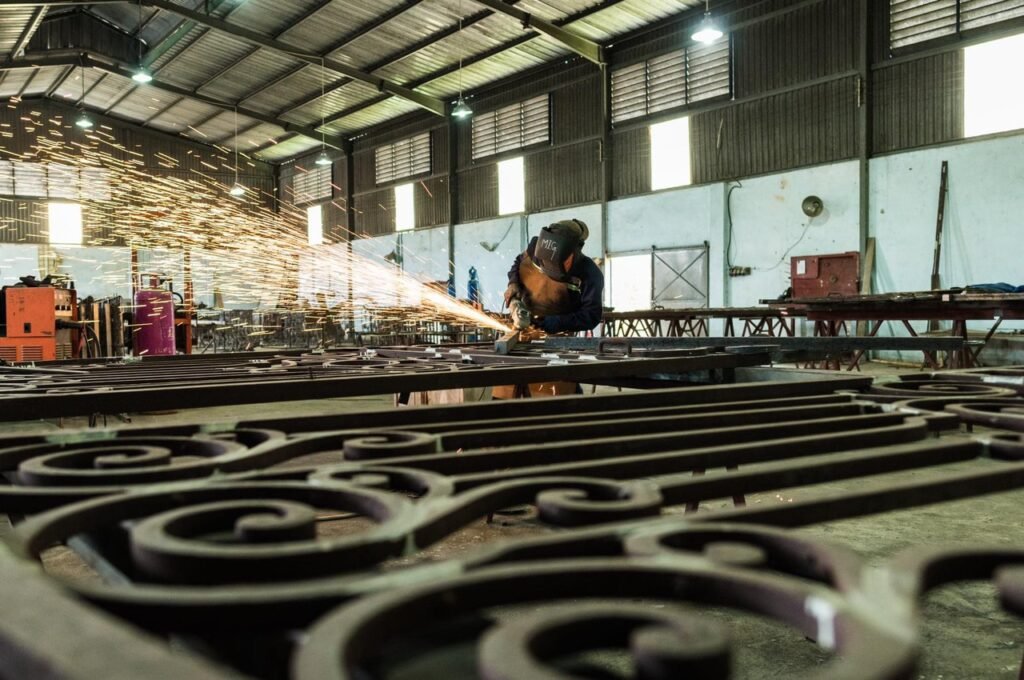Introduction
Vietnam has rapidly become a key player in the global metal manufacturing industry, emerging as a competitive alternative to countries like China and India. With a combination of cost-effective labor, advanced production capabilities, and a strategic location, Vietnam’s metal manufacturing sector is experiencing unprecedented growth. This article explores the key factors behind Vietnam’s success in the metal manufacturing industry, its strengths, opportunities, and challenges, as well as why global businesses are increasingly sourcing metal products from Vietnam.

Overview of Vietnam’s Metal Manufacturing Industry
Vietnam’s metal manufacturing industry plays a crucial role in the country’s economy, supplying raw materials and finished metal products to various industries, including automotive, construction, electronics, and aerospace. The industry consists of steel production, aluminum extrusion, casting, forging, and precision machining. Many Vietnamese manufacturers have upgraded their technology and processes to meet international standards, making them attractive partners for global buyers.
Key Sectors in Vietnam’s Metal Manufacturing Industry
- Steel Manufacturing
- Vietnam is one of Southeast Asia’s largest steel producers, with companies such as Hoa Phat Group, Hoa Sen Group, and Pomina leading the industry.
- Steel production supports infrastructure development, shipbuilding, and automotive manufacturing.
- Aluminum Production
- The demand for aluminum extrusion and die-casting is increasing due to its applications in construction and electronics.
- Companies like Tung Ho and Ngoc Diep Group are significant players in Vietnam’s aluminum industry.
- Casting and Forging
- The casting and forging sector in Vietnam is developing rapidly, catering to automotive, aerospace, and industrial machinery companies.
- Foundries in Vietnam specialize in sand casting, investment casting, and die-casting techniques.
- Precision Machining
- Vietnam’s CNC machining and metal fabrication capabilities have advanced significantly, allowing for the production of high-precision components for global markets.
- Many manufacturers export precision metal parts to the U.S., Europe, and Japan.
Advantages of Vietnam as a Metal Manufacturing Hub
1. Cost-Effective Production
One of the biggest advantages of sourcing from Vietnam is cost-effectiveness. The country offers competitive labor costs compared to China and other manufacturing hubs, while maintaining high-quality production. This allows businesses to optimize costs without compromising product standards.
2. Strategic Location
Vietnam’s location in Southeast Asia provides easy access to major markets such as China, Japan, South Korea, and ASEAN countries. With well-developed ports and logistics infrastructure, exporting metal products to the global market is efficient and cost-effective.
3. Government Support and Trade Agreements
Vietnam’s government actively supports the manufacturing sector through policies, incentives, and tax benefits. Additionally, Vietnam has signed multiple free trade agreements (FTAs), including:
- Comprehensive and Progressive Agreement for Trans-Pacific Partnership (CPTPP)
- EU-Vietnam Free Trade Agreement (EVFTA)
- Regional Comprehensive Economic Partnership (RCEP) These agreements lower tariffs and boost Vietnam’s attractiveness as a manufacturing destination.
4. Skilled Workforce and Technological Advancement
Vietnam has a growing pool of skilled engineers and technicians specializing in metal manufacturing. The country is also investing in automation and Industry 4.0 technologies, improving production efficiency and quality.
5. Diversification from China
Many global companies are adopting a “China +1” strategy to reduce reliance on Chinese manufacturers. Vietnam has emerged as a top choice due to its stable political environment, competitive costs, and expanding manufacturing capabilities.
Challenges Facing Vietnam’s Metal Manufacturing Industry
1. Raw Material Dependence
Despite its strong manufacturing sector, Vietnam imports a significant portion of raw materials such as steel and aluminum. This reliance on imports can lead to fluctuating costs and supply chain risks.
2. Infrastructure Constraints
While Vietnam has made significant improvements in infrastructure, certain areas still lack the logistical efficiency seen in more developed manufacturing nations. Transportation and energy supply remain key challenges for scaling production.
3. Environmental Regulations
As Vietnam’s metal industry grows, it faces increasing pressure to adopt sustainable practices. Strict environmental regulations are being implemented to control emissions and reduce waste from metal production.
4. Competition from Other Manufacturing Hubs
Countries such as India, Thailand, and Indonesia also offer competitive manufacturing environments. Vietnamese manufacturers need to continue improving quality, efficiency, and innovation to maintain their edge.
Future Outlook and Opportunities
Vietnam’s metal manufacturing industry is set for continued expansion due to rising global demand, foreign investment, and technological advancements. Several key trends shaping the future include:
1. Increased Foreign Direct Investment (FDI)
Global companies are investing in Vietnam to establish joint ventures and manufacturing plants. Countries such as Japan, South Korea, and Germany are major investors in Vietnam’s metal industry.
2. Growth in High-Value Manufacturing
Vietnam is moving beyond basic metal production to high-value manufacturing, including aerospace components, medical devices, and precision automotive parts.
3. Digital Transformation and Smart Factories
Vietnamese manufacturers are adopting digital manufacturing technologies, including IoT, AI, and automation, to improve efficiency and competitiveness.
4. Expansion of Renewable Energy for Sustainability
The adoption of solar and wind energy in manufacturing facilities is increasing to reduce carbon footprints and comply with environmental regulations.
Conclusion
Vietnam has established itself as a strong and reliable player in the global metal manufacturing industry. With cost-effective production, a skilled workforce, and government support, the country is attracting international buyers and investors. While challenges exist, Vietnam’s commitment to infrastructure improvements, technology adoption, and sustainability will further enhance its position as a leading metal manufacturing hub. Businesses looking for high-quality metal products at competitive prices should consider Vietnam as a top sourcing destination.
For more insights into the steel industry and customized metal solutions, visit LUX Metal.

